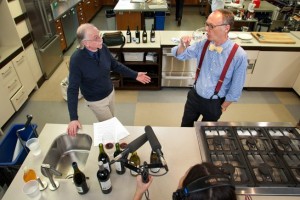
At least once a month we play a game in the wine corner at Formaggio Kitchen that we call three bottle monte. The name is an allusion to three card monte, the notorious New York City street game used by scam artists to fleece tourists and other innocents of their pocket money. The aim is to find the queen of hearts among three cards that have been shuffled with bewildering speed.
In the wine version we set out three bottles with their labels in plain sight, but only after we’ve poured their contents into three identical decanters. The player tastes each wine without knowing its identity. The test might be to correctly match each wine to its correct bottle, pick the chardonnay out from among three whites, or maybe just say which of the three is not like the others. There are lots of ways to set it up. Most people are not winners, of course, but that doesn’t seem to dampen enthusiasm. The purpose of the game isn’t to embarrass but to educate – and have some fun along the way.
Thinking it was high time we challenged Chris to play our favorite wine game on-air, we presented him with an interesting find-the-odd-man-out problem: to identify the one wine of three that “does not exist.” The trio consisted of two off-the-shelf single-varietal wines (a generic Beaujolais made from the gamay grape and a Spanish wine vinified with tempranillo fruit) plus one that I created myself by mixing the first two in equal proportions. The result was a blended wine that for various reasons does not and could not (under any reasonably foreseeable circumstances) exist.
A little background on blending: The reputation of some kinds of wine depends almost entirely on their being as near to a pure expression of their geographical source as possible. To achieve this hyperlocal character winemakers often rely on the technique of planting one vine variety in a single plot known to be favorable to it. The resulting wine is not blended with wine made from other grape varieties or which is sourced from another plot. For many experienced tasters, it’s precisely this “pure” expression of the land that provides their chief point of engagement with wine.
But for most of the wine world, blending—of grape varieties, vintages, vineyards—remains the norm, and for some very good reasons. Blending takes some of the risk out of the business of making wine, since one is not wholly dependent on one crop in one place. Also, with distinct lots of different wines at hand to use as if they were colors on a painter’s pallette, a winemaker can exercise a creativity not otherwise open to her. From a purely organoleptic point of view (how wine smells and tastes) it would be hard to argue that blended wines take a backseat to the one-grape-one-plot variety. Bordeaux, Champagne, and Chateauneuf-du-Pape are examples of very fine wines that depend on blending to achieve their characteristic profiles.
The process of selecting the various components of a blend and determining in what proportion to mix them is referred to by a French term: assemblage (ah-som-BLAHJ).
If you heard the segment on-air or vis the podcast, you know that Chris did a good job of identifying the one wine that was not like the other two, but he also suggested that all three were equally pleasing and drinkable.
Why not get a few friends together and play a bit of three bottle monte yourself? I can almost guarantee that whatever format you choose, you’ll learn a lot from the game.
Stephen Meuse can be reached at stephenmeuse@icloud.com